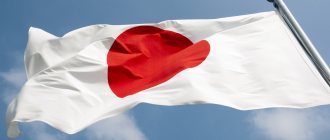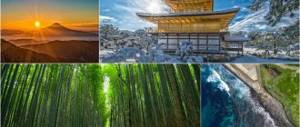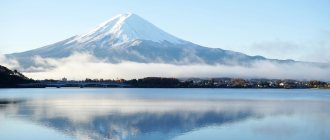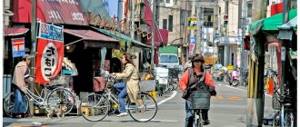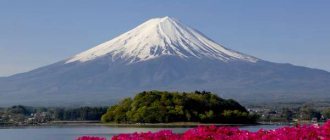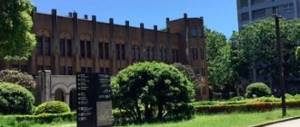There are practically no Russian universities in international educational rankings. But there are many Japanese higher education institutions there, and Tokyo and Kyoto Universities in Japan are consistently among the top 100 best. At the same time, the cost of studying there is an order of magnitude lower than at universities in the USA and Great Britain, and there is even a system of discounts and exchange programs for foreign students.
The highest rating in 2021 is from Moscow State University named after M.V. Lomonosov. He is in 174th place.
What the education system looks like in the Land of the Rising Sun, why it is considered one of the best in the world and what opportunities do Russian students have to study at universities in Japan - you will learn about all this from the article.
And to be the first to receive the latest news from the world of education, subscribe to our information resource. And don’t forget to take advantage of promotions and discounts.
Features of Japanese education
For a long time, the Japanese education system functioned with a bias towards the Sino-Korean teaching method. Only at the end of the 13th century did the situation change in favor of national priorities. For some time, private education and homeschooling were widespread. After 1868, the Japanese tried to adopt Western-style teaching methods and structures. A number of reforms to the educational system were carried out in Japan after World War II. Ultimately, a powerful educational structure was created - one of the best on the planet.
Conventionally, the entire cycle of education in Japan is divided into compulsory and optional. The first is based on preschool, primary, secondary education. The second is studying at senior level schools and universities. The academic year officially begins in April and is divided into three trimesters. The duration of the first is from 6.04 to 20.07, the second - from 1.09 to 26.12, the third - from 7.01 to 25.03. The time between trimesters is reserved for vacations.
Pre-school, primary and secondary education stages are compulsory
Clubs and festivals
The development of education in Japan goes back to ancient times. Already in the 6th century there was a national education system. The Japanese have always been supporters of early and harmonious development. This tradition continues today. In middle and high school, students are given the opportunity to attend hobby groups. Each circle is assigned its own scientific director, but he intervenes in the activities of the club only when there are upcoming competitions or creative competitions between schools, which happens quite often.
During the holidays, students attend excursions organized by the school. Trips are carried out not only within the country, but also abroad. After the trips, each class is required to provide a wall newspaper, which will detail everything that happened on the trip.
In high school, special attention is paid to such an event as the fall festival. The school allocates 30,000 yen for each class and purchases T-shirts. And the students are required to come up with an event to entertain the guests. Most often, cafeterias and fear rooms are organized in classrooms, creative groups can perform in the assembly hall, and sports sections organize small competitions.
A Japanese schoolchild has no time to wander the streets of the city in search of entertainment; he has enough of it at school. The government did everything possible to protect the younger generation from the influence of the street, and this idea worked out great for them. Children are always busy, but they are not mindless robots - they are given the right to choose. Students organize most school and university events independently, without the help of academic advisors. They come to adulthood fully prepared, and this is the main feature of education in Japan.
Structure and principles of the preschool level
Children spend their preschool education in nurseries and kindergartens. Nurseries actually do not perform any educational functions. This type of facility serves solely as child care and is supervised by the Japanese Ministry of Welfare and Labor . As a rule, children aged from 1 to 3 years attend the nursery.
Japanese kindergartens, unlike nurseries, are already officially included in the educational system and are included in the list of institutions subordinate to the Ministry of Culture and Education of Japan. Along with care functions, kindergartens prepare the audience for primary school. The standard age of children attending kindergartens is 3 - 6 years.
A notable requirement of most Japanese educational institutions is a uniform uniform for students. A significant part of such institutions have the status of subsidiaries of Japanese schools, colleges, and universities.
...Non-working mothers can send their child to etien from the age of 3. My friend's son goes to Yochien, and my son goes to Hoikuen, I haven't noticed any particular educational bias in Yochien. In Yochien, parents are strongly encouraged to participate in the life of the kindergarten in many aspects (cleaning, inventing competitions for the holiday, picking grass, etc.), there are also holidays like at school and children are usually in Yochien until 2 days, although from time to time time and must be picked up at 12 noon...
somersett
https://melon-panda.livejournal.com/368708.html?thread=15119940#t15119940
Structure of the Japanese educational system
The education of young Japanese is in many ways similar to that of Russia or Western Europe. Just like here, education in Japan is divided into several stages. True, students stay at school not until they are 17, but until they are 18, since complete secondary education here lasts 12 years.
Up to grade 9 inclusive, everyone studies for free. There is a small fee for studying in high school.
In terms of the number of university students per 1000 people, the Japanese education system lags behind Russia. According to 2010 data, the number of students in universities is only 2.8 million people. This is approximately 2.5 times less than in Russia, where there are about 7 million students. At the same time, the total population in the Russian Federation is only 20 million people more than in Japan (146 and 126 million people).
To find out how schoolchildren live in Japan, it is necessary to take into account some differences between the local education system and the Russian one. For example, the school year in this country begins not in September, like ours, but in the spring. High school students can study part-time. There are also a number of other features, which we will now discuss in more detail.
Preschool education
As in many other developed countries of the world, preschool education is a necessary stage in preparation for primary school education. In addition, the work of kindergartens and nurseries greatly simplifies the life of parents, allowing them to rationally distribute their time.
Nursery
Considering that a career is extremely important for the Japanese, many mothers cannot afford to take long maternity leave, preferring to send them to a nursery. This stage cannot be fully called preschool education, since the main purpose of the nursery is to look after the baby while the parents are at work.
You can send a child to a Japanese nursery from the age of 10 months to 3 years. Currently, there are about 23 thousand nurseries in the country, half of which are private and half are public.
In Japan, as in Russia, there is a problem of queues at public nurseries and kindergartens. In order for a child to be accepted into a preschool, parents must document that they have a permanent job during the day.
Kindergarten
Preschool education in Japan is not much different from Russia. Kindergartens accept children from 3 to 6 years old. Training and education are carried out in three age groups:
- younger (from 3 to 4 years old);
- middle (from 4 to 5 years);
- senior (from 5 to 6 years old).
There are almost 14 thousand kindergartens in Japan. Of these, more than 8 thousand are private, the rest are predominantly municipal. Depending on the prestige of a particular preschool institution, the admission of a new student may be accompanied by passing simple graphic tests. This allows us to identify the most capable children from a very early age.
A kindergarten in Japan that offers a creative development program or teaches the basics of the English language is most in demand among parents. As a rule, there are waiting lists for children to be admitted to such municipal preschool institutions. The monthly cost of placing a child in kindergarten can vary from 200 to 1500 US dollars.
Along with education, games and child care, preschools teach writing (Hiragana and Katakana) and basic arithmetic. The vast majority of children can already read by the time they enter first grade.
School education
When does the school year start in Japan? According to the local education law, children start school on April 6th. Unlike Russia, where almost the entire summer is reserved for vacations, in Japan they begin only on July 20, when schooling in the first trimester ends.
The second trimester begins on September 1. It continues until the winter holidays, which last from December 25 to January 6. The third trimester begins on January 7 and ends on March 25. At this time, cherry blossoms begin, which has a symbolic meaning for the Japanese.
Although discussions periodically arise in the country regarding starting the school year at the beginning of September, like in the rest of the world, most citizens have already become accustomed to the existing calendar and are not yet planning to change it.
It is not difficult to calculate how long the holidays last in total. Schoolchildren are given only three weeks for spring and winter holidays. Summer holidays in Japan last 1.5 months, which is almost half as long as in Russia.
Junior
Education in the lower grades begins at the age of 6 and is compulsory. The list of subjects in the local primary school is standard for many countries of the world: the state language, mathematics, music, natural history, drawing, etc.
How do boys and girls study in Japanese schools: together or separately? If we take into account state and municipal educational institutions, which make up the absolute majority, then education in them is joint. At the same time, there are more than 200 private schools in the country, some of which provide education only for girls or, accordingly, only for boys.
In all secondary schools, regardless of their status, students wear a school uniform.
Average
After 6 years of primary school education, children move to secondary school. Studying there lasts three years and is also compulsory. There are more than 11 thousand high schools in Japan, including about 700 private educational institutions. After grade 9, the student has the right to complete his studies or move to high school.
How do children in Japan study in middle school? The main difference from primary classes here is the wider list of subjects. Of course, as in Russia, the burden on the child increases every year. This is reflected in the number of teaching hours per week.
The list of subjects in secondary school looks like this:
- Japanese language and literature;
- mathematics (algebra and geometry);
- English language;
- physics;
- chemistry;
- story;
- geography;
- biology;
- music;
- art;
- physical training.
In private schools, the list of compulsory subjects may be supplemented, for example, by secular ethics or valeology. Unlike Russia, Japan does not use textbooks that are uniform for the entire country, but those that were selected by the education department of the local prefecture.
High school
After completing the 9th grade, students are given the opportunity to complete secondary education in high school. Formally, it is not mandatory, but statistics show that 94% of 9th grade graduates continue their education by moving to 10th grade. At the end of each school year, transition or intermediate examinations are held in middle and high schools.
Japanese high school includes 3 years of education - from 10th to 12th grade. After completing upper secondary education at the age of 18, former students may attempt to enroll in higher education or college.
In the 10th grade, students choose a specialization for further education - the humanities or physics and mathematics. Depending on the specialization, in each class on the stream the list of core subjects increases, and non-core subjects decrease. There are also additional optional lessons: medical training, agronomy, fishing, home economics, finance, etc.
Special education
The formal goal of continuing education in high school is admission to a higher educational institution. However, not all graduates become university students. Some of them enter technical or humanities colleges that have the status of secondary specialized educational institutions. Education in them, as in universities, lasts 5 years. Some colleges offer admission after 9th grade, others only after 12th grade.
A significant part of these colleges trains qualified technical specialists to work in industrial enterprises. Some of the technical schools are opened with money from large corporations that are interested in training personnel for their plants and factories. The advantage of technical colleges is that graduates of such educational institutions do not have problems finding work.
Secondary specialized educational institutions also include liberal arts and community colleges. The language school where they teach Japanese is very popular among graduates, and hotel business colleges are also of great interest.
For children with disabilities
Minors who are unable to attend school for health reasons have the right to receive the knowledge they need through individual or distance learning. The Internet is used to receive and check assignments, as well as for interactive communication with teachers via online video conference.
School at the Russian Embassy in Japan
Studying in Japan for Russians in 2021 is represented by only one secondary educational institution operating in Tokyo under the auspices of the Russian diplomatic mission. The school at the Russian Embassy in Japan is available to all children who wish to receive education in Russian, regardless of the citizenship of their parents.
To admit a child to this educational institution, you must write an application addressed to the Russian Ambassador to Japan, attaching a copy of the child’s birth certificate, a certificate of his health and the parents’ residence permit (if available).
Exchange studies are available to children and adults from the age of 13. Such programs are usually created by travel companies and language courses. The main goal of exchange study is to improve your Japanese or Russian language skills.
Read also: How to move to Japan How to obtain Japanese citizenship
Higher education
There are more than 700 universities in Japan, most of which are private. As in Russia, where education after the 11th grade is possible not only in universities, but also in technical schools or colleges, an alternative to Japanese higher education institutions are two-year community colleges, which accept students after the 12th grade. They are especially popular among girls. Such educational institutions train nurses, kindergarten teachers, and primary school teachers.
Higher education in Japan is always paid. It is possible to obtain a state scholarship to pay for university education only in exceptional cases. Every year, the state provides no more than 100-150 such scholarships for several hundred thousand applicants.
Despite the fact that you have to pay to enter the university, this does not exempt the applicant from taking entrance exams. Competition for the most prestigious universities reaches 20-30 people per place.
After completing their studies at the university (5-6 years), some graduates have access to a master's degree (2 years of study) and postgraduate study (3-4 years of study).
Japan Primary School Program
The structure of primary education is represented by standard educational institutions, as well as schools for disabled children. Children begin attending primary school at the age of six. This level of education is compulsory for all citizens of the country. The duration of training at this stage is 6 years. The main disciplines throughout the entire period of study are:
- Japanese language (including calligraphy),
- mathematics,
- humanities sciences,
- natural sciences,
- basics of life,
- art,
- music,
- work,
- physical training.
School students in Japan are required to wear uniforms.
There are institutions where secular ethics, religion, valeology and other subjects are taught. Primary school students are required to wear a uniform. Also, special attention is paid to the mandatory procedure for cleaning classrooms directly by students . For this purpose, a duty schedule has been organized among schoolchildren.
...I was very lucky with the school: the teachers are the kind you can only dream of; The classes are intensive, and the training is entirely aimed at ensuring that students immerse themselves in the language as much as possible. Thanks to this, I quickly got involved and after a couple of weeks I understood almost everything that our “sensei” said in class...
Margarita Diskina
https://gaku.ru/students/diskina.html
School
Education in Japan begins with kindergarten graduates who have reached the age of 6 . Almost all schools belong to the state. Only wealthy Japanese can afford to study in private schools, since the cost reaches 400 thousand yen , which is equivalent to 3.5 thousand dollars.
For Japanese children, the initial stage begins - school education. The first three classes include the study of basic subjects. Students are taught their native Japanese and English. Calligraphy is given special importance from the first grade. The main disciplines include: physical education, mathematics, fundamentals of art. Humanities and natural science subjects are added in the third grade.
School uniforms for junior students . To avoid getting lost while walking, you should have a yellow hat, rain cape and umbrella.
Secondary school education (junior level)
Traditionally, Japanese children begin to go through the secondary school stage at the age of twelve. The entire period of study takes three years and is also included in the compulsory education scheme. Subjects studied:
- algebra and geometry,
- Japanese (additionally English),
- biology,
- chemistry,
- geology,
- geography,
- physics,
- social science,
- story,
- art,
- labor skills,
- Physical Culture.
As part of an additional class hour, the following are studied: the history of the region, religion, valeology, pacifism, etc. An indispensable attribute of a high school student is a school uniform. Just like in elementary school classrooms, cleaning of premises by students is practiced.
In public schools, girls and boys study in the same class
As a rule, state educational institutions operate according to the scheme of general classes, where boys and girls study together. However, there are a number of private schools that practice single-sex education . Along with regular educational institutions, there are secondary schools for children with disabilities.
…Enrolling in the Japanese language school Yu Language Academy, studying and staying here in Japan is one of the important and very significant periods in my life. I believe and hope that “today” will become an impetus for an even more important “tomorrow”, but also a “future”...
Guboglo Irina
https://yula.jp/ru/voice-ru/
Senior high school level
Improvement of education is provided by senior secondary schools, which are, rather, a class of humanitarian or technical schools. At this level, training begins at the age of fifteen and lasts for three years. Education at the upper secondary level is no longer compulsory . And yet, about 95% of Japanese traditionally go through this level of education.
Video about Japanese schools
There are approximately equal numbers of public and private schools. Regardless of your status, you must pay for training. The main goal of high schools is to prepare students for entering a university. Along with the general subjects of compulsory study, students are taught:
- computer science,
- foreign languages,
- agronomy,
- medical basics,
- basics of industry,
- trading business,
- fishing,
- economy,
- political science,
- sociology,
- ethics.
At the senior level of secondary schools, extra-curricular activities are well developed. After the main hours of training, youth attend various clubs and sections:
- judo,
- kendo,
- kyudo,
- athletic,
- calligraphic,
- political-economic.
At Nanao City Senior High School, children wear the Sailor uniform.
One of the mandatory requirements in the learning process is the presence of a school uniform. Maintaining cleanliness and order in school premises is the responsibility of students.
...At first I planned to just go. There is not enough information in Russia, and I wanted to go and make up my mind here. Basically, I went with the goal of learning Japanese, while I planned to look for work in Japan. I already graduated from a university in Russia with a degree in design and worked. I thought that I would learn Japanese to the second level and look for a job. But when I arrived, I decided that I would go to college...
Lena
https://nihon-go.ru/zhizn-i-uchyoba-v-yaponii-chast-2-kak-stat-mangakoy-v-yaponii/
Education system in Japan:
- Japanese
:
05/10/2021 at 16:38
thanks for the info
Answer
- Zoya
:
09.24.2020 at 05:06
Can a Japanese person with a bachelor's degree go directly to graduate school without going through a master's degree?
Answer
Uncle
:
10.23.2020 at 10:01
No
Answer
:
08/21/2020 at 08:41
Is there a state program to help orphans enter university?
Answer
:
01/29/2020 at 23:12
Thank you very much for the information, very interesting!
Answer
:
01/15/2020 at 18:25
Interesting information
Answer
:
24.11.2019 at 13:52
Thank you very much, I was just preparing a presentation on social studies
Answer
:
04.11.2019 at 09:04
Thank you! very interesting and useful information!
Answer
:
20.11.2018 at 18:30
thanks for the info
Answer
Special education in Japanese
Japan has a widespread network of special education, including institutions for children with disabilities. The list opens with the so-called schools of mastery - Juku. The modern prototype of ancient Juku has been changed radically, but the principles of training remain at a high level. Mastery schools created in the 17th century were intended mainly to teach the art of wielding weapons (samurai swords). A little later, Juku teachers began to teach painting and calligraphy.
Modern special training in Juku provides students with significantly more knowledge and skills compared to standard school education. Therefore, in Japan this level of education is very popular, despite the significant financial costs (up to 20 thousand yen per month of attendance) that fall on parents.
According to statistics, students in approximately 15% of junior, 50% of middle and 99% of high schools additionally take the Juku level. Each of those who wants to take exams at a college, technical institute, or university certainly turns to Dzyuk . The Juku special education system trains future applicants to pass the university exam, if not 100%, then 95% accurately.
Special-purpose education is provided to the Japanese by vocational schools from the Senmon Gakko, Tanki Daigaku series, junior and technological colleges, and mixed schools. These types of educational institutions prepare professional personnel with the subsequent issuance of appropriate technical licenses and humanitarian certificates. Basically, they are all represented by private institutions. Hence the rather high cost of training.
Educational specialized college courses, among other things, help prepare for admission to Japanese universities. The prestige of these educational institutions, of course, is incomparable with Japanese universities. However, colleges are very popular among the population, as they provide an opportunity to easily find work in the labor market. Some of them are subsidiaries of famous Japanese universities.
Colleges are popular in Japan
Some VET schools in Japan:
- Aichi Kiwami College of Nursing (Aichi Kiwami College of Nursing),
- Chukyo Junior College (Chukyo Junior College),
- Fukuoka College of Health Sciences (Fukuoka College of Medical Sciences),
- Honan College (Henan College),
- Iwaki Junior College (Iwaki Junior College).
Additional studies
Extracurricular education in the Land of the Rising Sun is represented by tutoring schools, which are called “juku”. All of them are paid, and you can enroll in them from the 7th grade.
Juku lessons are held in the evening, up to 3 times a week. Visiting tutoring schools allows you to study the disciplines taught in a regular school more deeply and better prepare for exams.
Given the huge role that exam results play in later careers, almost all children in Japan attend juku, although it is not formally a compulsory part of education.
Higher or university education system
Almost 800 universities of various levels provide higher education to Japanese students. All of them are divided into state, national and private. Students need to spend four years of study to obtain a bachelor's degree. In some cases, a unique specialization requires completion of a six-year undergraduate course. A minimum of 2 years is allotted for master's studies. Three to four years must be spent on a postgraduate course.
Video about studying in Japan
Higher education in Japan is provided only on a fee basis . Meanwhile, the amount of tuition fees depends very much on the specialization and on the educational program.
Table: cost of education in Japan per year of study for Russians and not only
| Type of educational institution | Cost of education, JPY per year |
| Junior colleges | 1 100 000 – 1 350 000 ($10680 – $13100) |
| Colleges of Technology | 320 000 ($3000) |
| Vocational colleges | 980 000 — 1 411 000 ($9740 — $13350) |
| Japanese language institutes | 415 000 – 997 000 ($4100 – $9700) |
| Universities (undergraduate) | 770 350 – 4 920 500 ($7650 – $48900) |
| Universities (postgraduate studies) | 768 000 – 1 470 000 ($7630 – $14600) |
*JPY—Japanese yen.
The best and most popular Japanese universities are:
- Tokyo University,
- Kyoto University,
- Tohoku University,
- Osaka University,
- Tokyo Institute of Technology.
Photo gallery of popular universities in Japan
Oldest public university in Japan
Tohoku University is an educational institution that formerly had the status of an imperial university.
Kyoto University ranks second among the best universities in Japan
The University of Tokyo is a well-known university in Japan throughout the world.
The State Scientific and Technical University trains unique specialists
The University of Tokyo is a well-known Japanese university throughout the world, with unique research laboratory complexes . Provides the opportunity to study at any of ten faculties. Accepts up to 30 thousand students, including almost 3 thousand foreign ones.
Kyoto University is a national university, famous for the fact that at one time it was one of the imperial universities . It ranks second in the hierarchy after the University of Tokyo. Provides educational process for 22 thousand students.
Tohoku University is an educational institution that also had the status of an imperial university in the past . It has ten faculties, where 18 thousand students receive education. It is among the universities that have been selected by the Japanese government to introduce international education practices.
Osaka University is the largest university in Japan . The oldest educational institution, which in terms of the number of students is the largest in the country. Has the status of a state university. Officially opened as the sixth imperial educational institution.
Tokyo Institute of Technology is a prime example of a scientific and technical higher school . Managed by government agencies. The university has six schools and several research centers. Students have a choice of more than 40 faculties to study.
Video: overview of the University of Tokyo
Higher education institutions
The Japanese have a lot to choose from if they decide to get a higher education . There are more than 700 universities in the Asian country. The hierarchy of the highest level has three levels:
- Bachelor's degree – 4 years. They study general disciplines for two initial years, after which they move on to compulsory vocational training;
- Master's degree – 2 years. The student is faced with the task of writing a diploma and passing final exams;
- Postgraduate study – 3 years The doctoral title is defended by a dissertation based on scientific observations and experiments. You also cannot do without exam papers.
To become a certified doctor of medicine, studying at a university lasts 6 years.
The main difference between Japanese higher education is the lack of a schedule and list of subjects to study. Students independently formulate subject programs, determining the disciplines that are significant to them. Students are awarded points for attendance at lectures, active participation in seminars, and final exams.
Requirements for students from abroad
Admission to study in Japan is available to foreigners aged 17 to 35 years (including Russians, Ukrainians, Belarusians and Kazakhstanis). You must have a high school diploma (equivalent in status to a Japanese 12-year high school diploma) or proof of completion of studies at a higher level. Knowledge of Japanese is required . Priority is given to applicants from among promising students.
Attention is also drawn to the applicants’ knowledge of Japanese history, traditions, and mentality. Similar requirements are imposed by technical colleges, mixed schools, Juku additional education system and Japanese universities (undergraduate). Students or graduates of universities under the age of 35 with at least 16 years of education are accepted for master's and postgraduate studies.
The student exchange program accepts students aged 18 to 30 years. They must study in their home country at university faculties studying the Japanese language or Japanese culture. The documents requested are:
- letter of recommendation,
- certificate from the university faculty,
- medical certificate,
- a copy of the administration’s order to send you to study under an exchange agreement.
...The language requirements there are not just high, but very high. If you know Japanese at the age of 18, as they require, why go there to study at all? You can go to work right away. I don’t have a single friend who has passed the exam under the student program. Even those who successfully entered the master's program would not be able to pass this exam if they lived in Japan for more than one year. I’m not sure that you know the language at a level higher than the second kyu, you can freely read, write and understand the scientific speech of a Japanese professor who is giving a lecture...
Alexey Filatov
https://polusharie.com/index.php?PHPSESSID=0e3777dadc73b2840996a42c3fc4c194&topic=62771.msg524627#msg524627
What documents are needed?
To become a student at a Japanese university, you need to attach a TOEFL/JLPT certificate to a standard set of documents - passport, diploma or certificate and photo. In addition, some universities abroad ask for more specific information:
- Application for admission indicating 4 reasons. The student will have to write why he needs Japan , and why he wants to stay there (even if this is not the case).
- Your birth certificate and that of your parents. This is necessary to understand what kind of person he is before the state, and in what family he grew up.
- A copy of the international passport of the first country - if it does not arrive, it may fly away without the need to be sent to deport (payment at the expense of the state).
- Certificates from 3 teachers from the previous place of study. Russians can ask teachers from the school to write a recommendation for a graduate. But you need to confirm your identity by attaching copies of passports and certificates from your place of work.
- If a student is under 18 years of age, but wants to study in a preparatory course, he must attach a certificate from his parents’ place of work. This will confirm their solvency.
- Bank statement – The university must verify that the student has at least $15,000 in their account.
- Japanese health insurance - you can get it directly after passing all exams. The commission issues certificates to those who can provide an order from the university to enroll a student.
When accepting a student, the university It is impossible to obtain it from a consulate or embassy. After collecting all the documents, you need to pay for at least one year of training. The cost of studying abroad is 7-8 thousand dollars per year. Accommodation in a dormitory will cost a student $900-2000 per month. A student will have to spend about 800-1000 dollars per month on accommodation and support. Apartment rent will be $300 per month in the village, utilities – up to $300. Food and transportation - up to $400 (only necessary), medical insurance - $25-50.
If a student is studying in Tokyo, it is best to rent a room. A dormitory can cost several thousand dollars a month, and renting a one-room apartment can cost $1,500 (cheaper than a campus apartment). At the same time, you will have to spend money on transport and public services, which is not easy and difficult at first. Studying abroad in Japan causes a lot of controversy, but at the moment the country is considered one of the most stringent in terms of student selection and quality in the field of higher education.
Scholarships for students, including foreign ones
Against the backdrop of exclusively paid higher education, there is a slight deviation from the rules - scholarships from the Japanese government. However, this is a drop in the ocean. No more than 100 scholarships are awarded annually to 3 million students . And only very talented young people or people from low-income families can apply for government subsidies. Foreign students should not count on Japanese scholarships.
Even if a student manages to receive a scholarship, he will have to return the money received in the future. By the way, the scholarship amount, as a rule, does not fully cover all educational expenses. There are two options for applying for scholarships - before admission or immediately at the time of admission. The selection process for scholarship recipients is carried out by written examinations and oral interviews based on general education or specialized knowledge, as well as knowledge of the Japanese language.
Table: List of available scholarships for international students
| Scholarship type | Purpose | Amount, JYP per month |
| Government funding program | Undergraduate students of universities, colleges of technology, specialized colleges, Japanese language institutes engaged in research | 117 000 ($1160) |
| Private funding | Foreign applicants who have successfully passed the EJU exam and plan to enroll in regular studies at universities and colleges of various types | 48 000 ($480) |
| Student exchange support program (short-term study) | Foreign students who arrived under a student exchange agreement for a period from 8 days to 1 year | 80 000 ($795) |
*EJU (Examination for Japanese University Admission) – exam at the stage of admission to a Japanese university.
…The earth cooled down, dinosaurs became extinct, and one sunny spring evening, I decided to attend a presentation of training programs in various foreign countries. This was organized by representatives of various embassies and everything took place in St. Petersburg. This is how I learned about the Monbukagakusho scholarship and the Japanese government-supported research intern program...
Morpheus
https://habrahabr.ru/post/178277/
How can foreigners enter a Japanese university?
There are two ways to enter a Japanese university. If an applicant speaks only Russian and English, then theoretically the doors are open only to those universities where most or all subjects are taught in English. There are not so many of them and the competition is quite high, since along with Russian citizens, a large number of young Chinese and Koreans also want to study in Japan. Everyone will still have to take exams.
Another option involves partial naturalization of a foreigner. If a Russian student completes the 12th grade in a Japanese school, he will receive a local certificate of secondary education. Formally, this equates the student to Japanese applicants. Therefore, he can apply to any higher educational institution in the country.
Specified Requirements
According to local education law, to enter a Japanese university, an applicant must have completed 12 grades and be at least 18 years of age. Despite the fact that training is paid, all future students, including foreign citizens, take an entrance exam. It is universal for all universities and includes the following disciplines:
- Japanese language;
- profile subject;
- Japan and the world (for foreigners – interview);
- mathematics.
If a foreigner enrolls in a group where teaching will be conducted in English, he will take the entrance exam in English.
Applying for a student visa
How to go to study in Japan? Firstly, anyone wishing to study at Tokyo or Osaka University should take into account that they will not be issued a student visa until they are enrolled in the student list. They will have to come to take the entrance exam on a regular tourist visa. It is issued for a period of 30 to 90 days. This is quite enough to pass the exams.
A student visa to Japan, valid for 12 months and renewable annually, is issued on the basis of a valid study contract. It comes into force after the rector of the university issues an order to enroll a foreign applicant. If the student is already in Japan, then based on the study contract, he can apply for a residence permit in Japan.
Renewal procedure
Since the period of study at any Japanese university (except for two-year community colleges) is 5 to 6 years, every foreign student without a residence permit will be forced to regularly renew his visa. This is usually done in March or April, after the end of the next academic year.
To extend a student visa, you must contact the migration department of the Ministry of Justice of the city where the foreigner lives. You must first obtain a certificate from the university confirming your further studies.
If a foreigner is already in his home country after the end of the next academic year, then an application for visa extension is submitted to the Japanese consulate. This can be done in Moscow or St. Petersburg.
Required documents for admission
The list of documents that an applicant needs to prepare for submission to a Japanese university is as follows:
- statement;
- photocopy of the first pages of the passport;
- biography;
- school certificate;
- a document confirming completion of college or first year studies at a Russian university (only for those who have completed 11 classes);
- health certificate;
- recommendation from a Japanese language teacher (if available);
- two photos;
- bank account statement or letter of guarantee from the sponsor - a citizen of Japan;
- TOEFL certificate confirming the level of English language proficiency (for those planning to study in an English language group).
All documents in Russian must have a notarized translation into Japanese.
Exams
In addition to passing an exam in a core subject and an interview, each foreign applicant passes a test called “Nihongo noryoku shiken”. It determines your level of Japanese language proficiency.
Test tasks have 5 difficulty levels. Along with written answers, where the examinee must choose the correct option among those proposed, a listening test is also carried out. Depending on how many points the applicant scores, this result will be taken into account when enrolling as a student.
Scholarships and grants
As already mentioned, Japanese universities rarely provide grants for training. However, this mostly applies to local applicants. There are still several interesting programs for foreigners, each of which fully or partially covers training costs. These include:
- Japanese government scholarship for foreign students studying the language and culture of the country;
- international scholarship program for women (only for those who already have a bachelor's degree);
- Honyo Foundation Scholarship (for foreigners who are already enrolled in a master's or graduate program at a Japanese university);
- Japanese government scholarship for young leaders (for graduates of Russian universities under 35 years of age with management experience);
- Matsumae International Foundation scholarships (for candidates of science wishing to conduct research at Japanese universities).
As a rule, private and public scholarships cover a foreigner's monthly expenses in the amount of 100 to 250 thousand yen (1-2.5 thousand dollars). Additionally, air tickets and accommodation are paid for by the inviting party.
Cost of education
When planning to study at a Japanese university, you should not expect that you will be able to study for free. If the applicant fails to secure the support of any private or international foundation, it is better to forget about the payment discount.
How much does it cost to study at a Japanese university? Depending on the status and prestige of the university, as well as the specialty for which the foreigner is going to study, the fee for one year of study is 400-900 thousand yen (217-489 thousand rubles).
Living conditions for foreign students
Nonresident students of Japanese universities can live in a dormitory (residence) on the student campus. This option is the most economically advantageous, since living in a hostel is much cheaper than renting a home. However, there are also disadvantages here. Rooms for students are designed for 2-3 people, the kitchen and bathroom are shared. There is a curfew after 23:00.
Some Japanese students, when moving to another city, practice this type of living as guest families. In practice, this looks like renting a room in a private house.
According to statistics, more than 70% of Japanese students rent independent housing off campus. The disadvantage of this option is not only the high rent, but also the need to purchase furniture. In Japan, as in the USA, apartments are rented only with a refrigerator and kitchen furniture. Everything else will have to be purchased.
Exams for schoolchildren and applicants
The Land of the Rising Sun follows modern principles of education. Like the countries of Europe and America, the Japanese take a national exam - a kind of analogue of the Unified State Exam. True, the test is called a little differently - National Test for University Admissions.
In practice, the Japanese take the exam twice - after completing junior high school (12 years of study) and before entering higher education institutions. To study at colleges of technology and some universities, one National Exam is usually sufficient. However, applicants to prestigious universities, as a rule, additionally go through a sieve of internal university tests.
It should be noted that there are strict requirements for passing the national test and internal university exams. Perhaps this is one of the factors that has had an effective positive impact on the quality of the Japanese school. Can only be submitted once. There are no retries allowed.
The national exam is usually held in mid-January. The entire process takes two days. The organizer and administrator of the event is the Independent Institute of Administration (AIA) of the Japanese Student Assistance Organization (JASSO). The organization was created by the Ministry of Education, Culture, Sports, Science and Technology.
Table: disciplines for passing Japanese exams
| Exam subject | Maximum number of points for a set | Response time, min |
| Political economy | 100 | 60 |
| Social studies | 100 | 60 |
| Ethics | 100 | 60 |
| Sociology | 100 | 60 |
| Story | 100 | 60 |
| Geography | 100 | 60 |
| National literature | 200 | 80 |
| One of the foreign languages (5 in total): English, Chinese, Korean, French, German | 200 | 80 |
| Science: chemistry, physics, geology - to choose from | 100 | 60 |
| Biology | 100 | 60 |
| Mathematics | 100 | 60 |
| Information Technology | 100 | 60 |
...Actually, I used to think that there would be no exam as such, because I had already taken tests at the embassy when I applied for the MEXT program for which I came to Japan. Well, or it will be something very simple. Not so...
BURLAKIN
https://burlakin.livejournal.com/8823.html
Popular Universities
Although there are more than 700 higher education institutions in Japan, only a few are considered prestigious. This number includes the following.
| Universities in Japan | Number of students | Note |
| Tokyo University | 30000 | Founded in 1877, it has 12 faculties. It ranks 12th in the global ranking of universities, behind universities in the USA and Great Britain. |
| Teikyo | 21000 | Founded in 1966 in the Tokyo suburb of Itabashi. It has 8 faculties and 5 campuses, two of which are located in Tokyo, the rest in other cities of Japan. |
| Osaka University | 25000 | Founded in 1931 in Osaka. It ranks 63rd in the ranking of the best universities in the world. In addition to other specialties, it provides medical education. |
| Nagoya University | 10000 | Founded in 1939. Located in 72nd place in the ranking of the best universities in the world. A significant number of students are citizens of other countries (China, Korea, etc.). |
| Tohoku | 18000 | Founded in 1907. Located in Sendai. Ranks 102nd in the “Best Universities in the World” ranking. In 30 specialties, teaching is conducted in English. |
Universities accepting foreigners in 2021 do not exist in all provinces of Japan. Some of them have groups where instruction is taught only in English, while others teach exclusively in Japanese. For detailed information about admission conditions, it is best to visit the official website of the educational institution. As a rule, almost all local universities duplicate information for applicants in English.
Accommodation for foreign students
Japan is an expensive country for an international student, not only in terms of tuition fees, but also in terms of living costs. A student’s monthly budget directly depends on his lifestyle and the chosen place of study. The capital of Japan, Tokyo, is considered the most expensive city. For example, students who choose Tohoku or Kyushu have a good chance of saving about 30% when compared to living in Tokyo.
Most Japanese universities have in reserve the necessary supply of living space that can be used for foreign students. These are their own campuses, as well as rooms or apartments rented by the university. On average, for a student, the amount of payment for such living space is 25,000 - 50,000 JPY per month.
There are options for using the private sector. Foreign students can rent separate apartments or rooms. A popular type of accommodation is guest houses. In any of these options, the costs will be approximately 30,000 – 100,000 JPY per month.
Japanese language schools
As already noted, you can apply to a university only after studying preparatory courses (at least two semesters). To do this, some applicants use distance learning programs, but in most cases, future students study in Japan itself. In this case, when applying for a visa, the administrator of the language school becomes the guarantor issuing the invitation. There are similar educational institutions in all major cities of Japan:
- Tokyo;
- Fukuoka;
- Kobe;
- Sapporo;
- Yokohama.
These schools provide an opportunity to meet fellow foreigners who want to learn Japanese and enlist the support of teachers (almost all teachers speak English). Tuition costs start from $2,000 per semester.
Conditions for obtaining a student visa
Upon enrollment to study in Japan, the educational institution must apply on behalf of the foreigner to the regional Immigration Bureau regarding registration of his residence status. The completed document is sent to the student’s place of residence in his country. Next, all that remains is to apply with this document to the Japanese embassy for a student visa. However, based on the existing document, you can obtain a visa directly at the time of departure by contacting the airport customs service.
Student visa can be issued for 2 years or more
It is not excluded that you can independently apply for a student visa without receiving a document granting status. But this process may take a long time, since you will have to send a large package of documents to Japan for processing. Beginning in 2012, some changes came into force. From this moment on, students are issued a Resident Card, which is valid until the full completion of their studies. It is no longer necessary to apply to the authorities for permission to re-enter in case of temporary departure from the country. The visa validity period may be:
- 4 years 3 months,
- 4 years,
- 3 years 3 months,
- 3 years,
- shorter term (for graduate students).
Work during study and additional courses
The process of obtaining an education in Japan for foreign students does not include simultaneous employment. If a foreign student needs a job as additional financial support, he must submit an application to the dean’s office regarding a possible work permit. Such permission may be issued provided there is no harm to the student's educational process. In any case, during their studies, foreign students are allowed to work no more than 28 hours per week. As for courses, foreigners most often use them outside of their main studies to improve their knowledge of the Japanese language.
Juku
A unique phenomenon of Japanese schools is juku. This is a kind of tutoring school. Almost all middle and high school students attend them.
There are two types of juku:
- Academic - here teachers consolidate knowledge on school subjects or teach material that is not studied in class.
- Non-academic – work to discover and develop talents. Children can engage in different types of activities based on their own wishes - the art of ikebana, judo, the basics of the tea ceremony, theatrical performances, singing, board games.
Children visit juku in the evening after school 3-4 times a week.
Summary table: pros and cons of Japanese education
| pros | Minuses |
| High level of education | It is very difficult to pass the Japanese university entrance exams |
| There are public and private scholarships | It is almost impossible for foreign students (undergraduate) to get a scholarship |
| Living conditions for students are at a high level | The high cost of student life and especially in Tokyo |
| An effective system for conveying knowledge to students | In some subjects, knowledge can only be obtained through lectures. |
Japanese education is ahead of many European countries in its development. For people seeking to gain a truly high level of knowledge, studying in Japan is certainly a winning option. However, foreigners need to have a very strong background to stand a chance of winning a student card to Japan. Money here will only help in the form of official tuition fees.
- Author: Vladimir Bulgakov
Amateur analyst with a diploma. Copywriter. Rate this article:
- 5
- 4
- 3
- 2
- 1
(5 votes, average: 5 out of 5)
Share with your friends!
Some more interesting facts
- There is no homework in elementary school
- Girls are not allowed to wear makeup, and the only allowed accessory is a watch.
- Instead of cleaners, the students themselves clean the classrooms and grounds.
- Time for students to work part-time is no more than four hours daily.
Of course, like any educational system, the Japanese one also has its pros and cons. For example, undeniable advantages include prestige on the world stage, a high level of knowledge acquired, and guaranteed subsequent employment. There is perhaps only one downside - a very high price.


